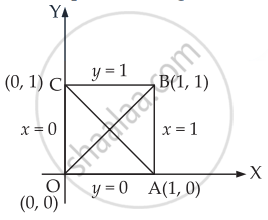Advertisements
Advertisements
प्रश्न
Equations of diagonals of the square formed by the lines x = 0, y = 0, x = 1 and y = 1 are ______.
विकल्प
y = x, y + x = 1
y = x, x + y = 2
2y = x, y + x = `1/3`
y = 2x, y + 2x = 1
उत्तर
Equations of diagonals of the square formed by the lines x = 0, y = 0, x = 1 and y = 1 are y = x, y + x = 1.
Explanation:

Given equation x = 0, y = 0
x = 1 and y = 1 form a square of side 1 unit
From figure, we get that OABC is square having corners O(0, 0), A(1, 0), B(1, 1) and C(0, 1)
Equation of diagonal AC
y – 0 = `(1 - 0)/(0 - 1) (x - 1)`
⇒ y = – (x – 1)
⇒ y = – x + 1
⇒ y + x = 1
Equation of diagonal OB is y – 0 = `(1 - 0)/(1 - 0) (x - 0)`
⇒ y = x
APPEARS IN
संबंधित प्रश्न
Find the slope of a line, which passes through the origin, and the mid-point of the line segment joining the points P (0, –4) and B (8, 0).
Without using the Pythagoras theorem, show that the points (4, 4), (3, 5) and (–1, –1) are the vertices of a right angled triangle.
Find the slope of the line, which makes an angle of 30° with the positive direction of y-axis measured anticlockwise.
If three point (h, 0), (a, b) and (0, k) lie on a line, show that `q/h + b/k = 1`
Find the slope of the lines which make the following angle with the positive direction of x-axis:
\[\frac{3\pi}{4}\]
Find the slope of the lines which make the following angle with the positive direction of x-axis: \[\frac{\pi}{3}\]
Find the slope of a line passing through the following point:
\[(a t_1^2 , 2 a t_1 ) \text { and } (a t_2^2 , 2 a t_2 )\]
Find the slope of a line passing through the following point:
(3, −5), and (1, 2)
Find the slope of a line (i) which bisects the first quadrant angle (ii) which makes an angle of 30° with the positive direction of y-axis measured anticlockwise.
What can be said regarding a line if its slope is negative?
Show that the line joining (2, −5) and (−2, 5) is perpendicular to the line joining (6, 3) and (1, 1).
Without using Pythagoras theorem, show that the points A (0, 4), B (1, 2) and C (3, 3) are the vertices of a right angled triangle.
Find the angle between the X-axis and the line joining the points (3, −1) and (4, −2).
Find the value of x for which the points (x, −1), (2, 1) and (4, 5) are collinear.
By using the concept of slope, show that the points (−2, −1), (4, 0), (3, 3) and (−3, 2) are the vertices of a parallelogram.
Find the equations of the straight lines which cut off an intercept 5 from the y-axis and are equally inclined to the axes.
Find the equations of the altitudes of a ∆ ABC whose vertices are A (1, 4), B (−3, 2) and C (−5, −3).
Find the angles between the following pair of straight lines:
3x + y + 12 = 0 and x + 2y − 1 = 0
Prove that the points (2, −1), (0, 2), (2, 3) and (4, 0) are the coordinates of the vertices of a parallelogram and find the angle between its diagonals.
Show that the tangent of an angle between the lines \[\frac{x}{a} + \frac{y}{b} = 1 \text { and } \frac{x}{a} - \frac{y}{b} = 1\text { is } \frac{2ab}{a^2 - b^2}\].
The coordinates of the foot of the perpendicular from the point (2, 3) on the line x + y − 11 = 0 are
If the slopes of the lines given by the equation ax2 + 2hxy + by2 = 0 are in the ratio 5 : 3, then the ratio h2 : ab = ______.
Find the equation to the straight line passing through the point of intersection of the lines 5x – 6y – 1 = 0 and 3x + 2y + 5 = 0 and perpendicular to the line 3x – 5y + 11 = 0.
The two lines ax + by = c and a′x + b′y = c′ are perpendicular if ______.
The intercept cut off by a line from y-axis is twice than that from x-axis, and the line passes through the point (1, 2). The equation of the line is ______.
If the equation of the base of an equilateral triangle is x + y = 2 and the vertex is (2, – 1), then find the length of the side of the triangle.
The point (4, 1) undergoes the following two successive transformations:
(i) Reflection about the line y = x
(ii) Translation through a distance 2 units along the positive x-axis Then the final coordinates of the point are ______.
One vertex of the equilateral triangle with centroid at the origin and one side as x + y – 2 = 0 is ______.
The line `x/a + y/b` = 1 moves in such a way that `1/a^2 + 1/b^2 = 1/c^2`, where c is a constant. The locus of the foot of the perpendicular from the origin on the given line is x2 + y2 = c2.
